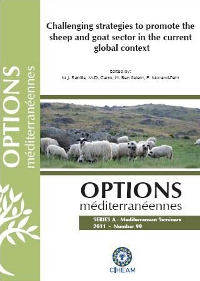| Article précédent | p. 41-46 | Article suivant |
Digestibility and ruminal fermentation of diets differing in forage type and forage to concentrate ratio in sheep and goats
The aim of this work was to compare digestibility and ruminal fermentation variables in sheep and goats fed good-quality diets at similar levels of intake. The four experimental diets had forage:concentrate ratios of 70:30 (H) or 30:70 (L) and either alfalfa hay (A) or grass hay (G) as forage. Four Granadina goats and 4 Merino sheep fitted with ruminal cannulae were used in a 4 x 4 Latin square design. Animals were fed the diets at a daily rate of 56 g dry matter (DM)/kg body weight0.75 to minimise feed selection. Intake of neutral- detergent fibre (NDF; g/kg body weight0.75) was lower in goats compared to sheep for HA, LA and HG diets (P=0.02, 0.03 and 0.02, respectively). No differences between AS were found in either DM (P =0.28) or NDF digestibility (P=0.23), but crude protein digestibility of HA and LG diets was 4.9 and 12.1 percent greater in goats than in sheep. Ruminal pH and proportions of propionate and isoacids were similar (P>0.05) in both animal species, but VFA concentrations in ruminal fluid were greater (P<0.003) and those of NH3-N lower (P<0.01) in sheep. Sheep presented lower acetate and greater butyrate proportions (P<0.05) than goats with H diets, but no differences (P>0.05) were found with L diets. Total protozoa numbers were 5.8 and 3.7 percent greater in goats than in sheep for LA and LG diets, respectively, but no differences (P=0.10) were found in the proportion of Holotricha. The results indicate that both AS can show similar digestive capacities when they are fed good-quality diets at a restricted level of intake, in spite of subtle differences in ruminal fermentation.
L'objectif de ce travail est de comparer la digestibilité et la fermentation ruminale chez les ovins et les caprins recevant des régimes de bonne qualité à des niveaux d'ingestion similaires. Les quatre régimes expérimentaux ont des rapports fourrage:concentré 70:30 (H) ou 30:70 (L) et de foin de luzerne (A) ou de foin de graminées (G) comme fourrage. Quatre chèvres Granadina et 4 ovins Merinos munis de canules au rumen ont été utilisés selon un dispositif en carré Latin (4 x 4). Les animaux ont été nourris à un taux quotidien de 56 g de matière sèche (DM) / kg de poids 0,75 afin de réduire la sélection de l'aliment. L'ingestion des fibres totales (NDF, g / kg de poids0,75) était plus faible chez les chèvres par rapport aux ovins pour les régimes HA, LA et HG (P = 0,02, 0,03 et 0,02, respectivement). Aucune différence entre les espèces animales n'a été trouvée dans la digestibilité de la DM (P = 0,28) ou NDF (P = 0,23), mais la digestibilité des protéines brutes des régimes HA et LG a été de 4,9 et 12,1 pour cent supérieure chez les chèvres par rapport à celle obtenue chez les ovins. Le pH du rumen et les proportions de propionate et isoacides étaient similaires (P > 0,05) pour les deux espèces animales, mais les concentrations des VFA dans le liquide ruminal ont été plus importantes (P < 0,003) et celles de NH3-N plus faibles (P < 0,01) chez les ovins. Les ovins ont une proportion d'acétate plus faible et de butyrate plus élevée (P <0,05) que celles trouvée chez les chèvres recevant le régime H, mais aucune différence de ces acides gras volatils n'a été constatée entre les deux espèces animales (P > 0,05) soumis au régime L. Le nombre total de protozoaires a été 5,8 et 3,7 pour cent plus élevé chez les chèvres que chez les ovins recevant les régimes LA et LG, respectivement, mais la proportion de Holotricha. L n'a pas été affectée (P = 0,10). Les résultats montrent que les caprins et les ovins peuvent avoir des capacités digestives similaires lorsqu'ils sont nourris avec des régimes de bonne qualité.
- [ Afficher ]
- [ Télécharger ]
- [ Exporter la citation ]
Vous pouvez télécharger la citation au format :
- [ Imprimer ]
-
Mots-clés
ALIMENT CONCENTRE POUR ANIMAUX, CAPRIN, DIGESTIBILITE, DIGESTION DU RUMEN, FOURRAGE, OVIN, REGIME ALIMENTAIRECiter cet article
Ramos S., Molina Alcaide E., Cantalapiedra-Híjar G., Yáñez Ruiz D.R., Tejido M.L., Carro M.D. Digestibility and ruminal fermentation of diets differing in forage type and forage to concentrate ratio in sheep and goats. In : Ranilla M.J. (ed.), Carro M.D. (ed.), Ben Salem H. (ed.), Morand-Fehr P. (ed.). Challenging strategies to promote the sheep and goat sector in the current global context. Zaragoza : CIHEAM / CSIC / Universidad de León / FAO, 2011. p. 41-46. (Options Méditerranéennes : Série A. Séminaires Méditerranéens; n. 99). 13. International Seminar of the Sub-Network on Nutrition of the FAO-CIHEAM Inter-Regional Cooperative Research and Development Network on Sheep and Goats, 2009/10/14-16, León (Spain). http://om.ciheam.org/om/pdf/a99/00801534.pdf



